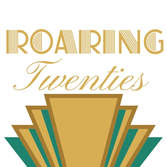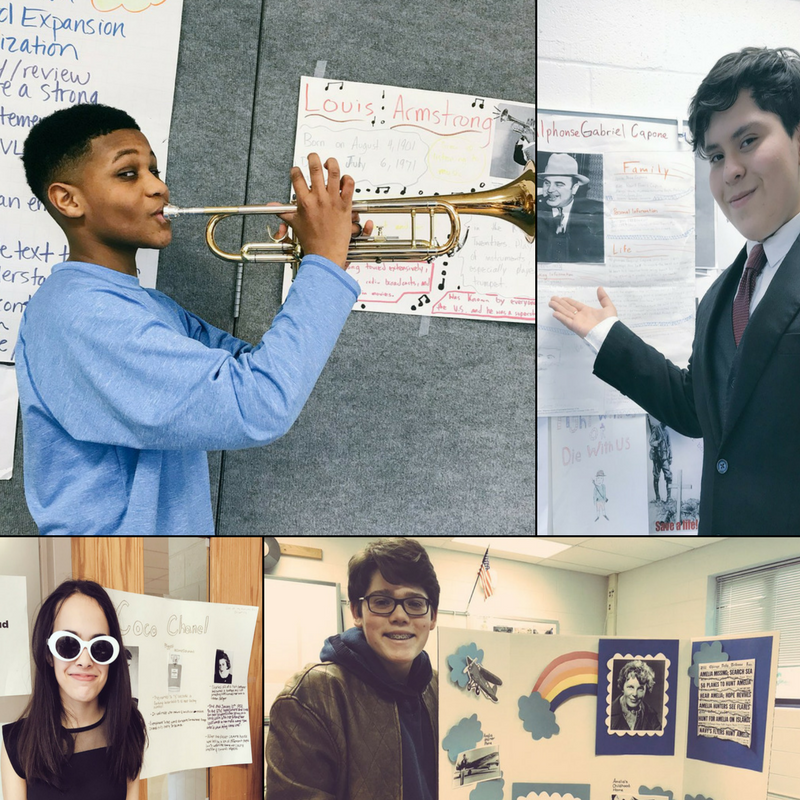 A few weeks ago I was looking for something new to try with my students in our 1920's Unit. I think a critical part of teaching is to change things up -- to keep your teaching and in turn, student learning fresh and vibrant. Gretchen mentioned that her son Charlie was doing a Wax Museum Project in his 7th grade history class. Yes! This was the answer. I have to give a shout out to his history teacher (and my friend): Carrie Guild of Rachel Carson Middle School. Carrie -- If you're reading this know that learning about your project inspired me: thanks! I took the idea of a wax museum and ran with it. My students presented last week and it was a great success. This project has it all: collaboration, research, communication, creativity, learning, public speaking and technology. Plus, it is versatile and really will work for any unit involving a variety of influential people. I'm going to give you a little run down of what I did (with the help of our fantastic librarians: Gretchen and Susanna). I've also linked to a few resources and handouts. I hope the idea helps you in your lesson development -- when teachers share, great ideas BubbleUp! So here's the basic framework: Before the lesson: Create a list of influential people in the unit of study. Day One: Students draw names of those influential people -- but allow them to trade. I did this toward the end of the class period as this process only took about 15 minutes. And please note, that I don't have block scheduling so I was doing this project within 45 minute class periods. Explain that they will be creating an exhibit about an individual. The exhibit will involve a poster (with facts, pictures, work examples and citations) and either a costume or an artifact. I didn't want to require that students dress up (as I know that can be intimidating for some students and/or a monetary or time burden for some families) so I also gave them the option of bringing in an artifact from home or creating their own artifact. I provided students with this rubric/checklist and research page. Day Two: Focus on research. Our librarians pulled books and articles on the noteworthy individuals and also posted links to our research databases on their library website. Additionally, we offered a link to EasyBib so that students could be sure to keep track of their citations. I created this page for students to collect their research. Some students opted to answer the questions on their own paper or to type their research into a Google doc. Fine by me. Day Three: Students made their posters on large chart paper (nothing fancy, nothing expensive). We had colored markers, glue sticks, scissors and access to a printer for them to print out a few photos and put them on the poster. They were also required to print out their citations or to write them on the poster. Day Four: Practice presentations. First, we brainstormed a list of what makes a good presentation. Next, I gave each students an index card and asked them to take 8 minutes to write down what they would like to talk about in their brief presentation. Then I divided students into two groups. Group A found a partner in Group A and they practiced and offered feedback and then practiced again with the feedback in mind. Group B did the same thing. I really liked stressing the importance of presenting . All too often students don't practice and then their presentations are a train wreck for the presenter and the audience. I used the analogy of outside activities. In soccer, you don't do the drill once - you do it hundreds of times. In swimming, you don't swim one lap and call it a day. Your dance teacher doesn't teach you a dance one time and then expect you to know how to do it. Practice and feedback should be a way of life. Day Five: Group A hung up their posters around the room and then presented in costume or with their artifact. Meanwhile, Group B went from exhibit to exhibit with this note page to learn about each of the individuals. At the same time, I traveled to the exhibits -- student presenters would hand me their rubric and research page and I would then assess them as they presented. This is a great teacher benefit -- no extra grading at home! Day Six: Group B presents and Group A watches presentations and takes notes. After the Project: I realized that Group A would miss other presenters in their group and the same would hold true for Group B. Because I really want students to learn this content so I then assigned one component to be completed at home -- students would have four days to put their presentations up on a Flipgrid that I created for each class. They would then be responsible for visiting the grid to learn the rest of the content. What I like About this Project As a middle school teacher and the mother of two elementary aged students I am not big into a lot of homework. I don't think it is super valuable to overload kids with giant projects -- and that's one reason I liked this project. It was primarily done in the classroom and didn't require parents to go out and purchase extra items. Now of course, some of my students did indeed take things to the next level -- but the kids who kept things simple got awesome grades too and managed to learn the content. It was so wonderful to see so many kids engaged and I heard through the grapevine that one kid who wasn't in my class was bummed to be missing out because it sounded like so much fun. When kids think school is fun -- I win! And well, so do they. Another great thing about this project is you can make it as elaborate or simple as you want. I didn't have my students use a ton of resources. One academic source was enough for me -- it was more about quality than quantity but you could definitely make it more in-depth if that's what your students need. Lastly, every student was involved in teaching and learning. Engagement was through the roof. One of my colleagues walked in and her remark was this room is "Buzzing! -- what an awesome project." She was right. The students were doing the work -- and hence the learning. Plus, even students who struggle with presenting got the chance to see their peers presenting and therefore, modeling a quality presentation. What was a Challenge This activity creates a lot of noise and it looks like chaos even when it isn't. You have to be prepared for your classroom to be torn apart and to get noisy. It can also be a challenge for students who have trouble maintaining focus -- particularly when they are not presenting. Because I need to watch the presentations and visit the exhibits I had to trust my students to do the right thing -- and for the most part I think they were successful. That said, it's best to go into it with eyes wide open. Second, as with anything some kids didn't manage to produce what they were expected to so I have a few reluctant learners that I will be playing catch up with in the days to come. But that's always going to be the case when you ask kids to create something. Have you done a Wax Museum or Artifact Exhibit Project? We'd love to hear from you! -Corey You might also like:
0 Comments
Your comment will be posted after it is approved.
Leave a Reply. |
Who We Are
Join our list!Archives
September 2020
Categories
All
|







 RSS Feed
RSS Feed